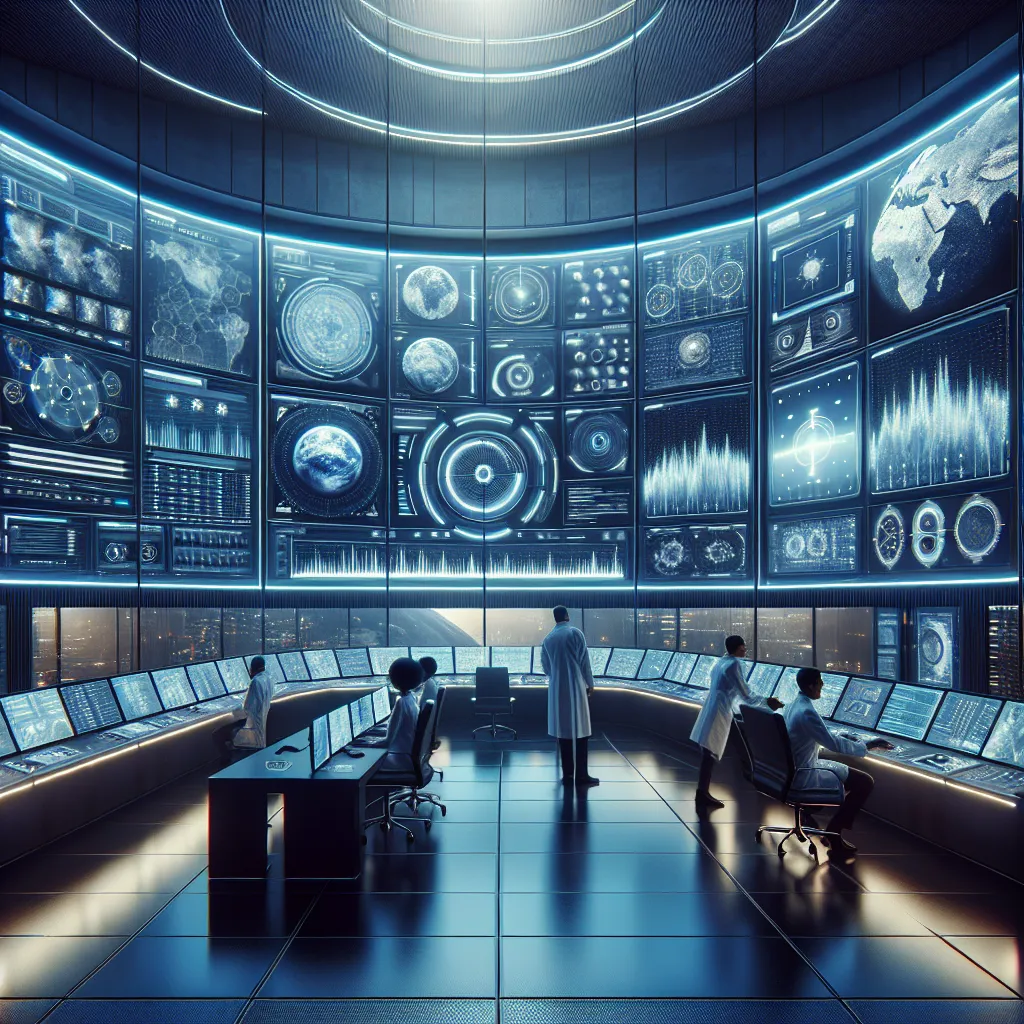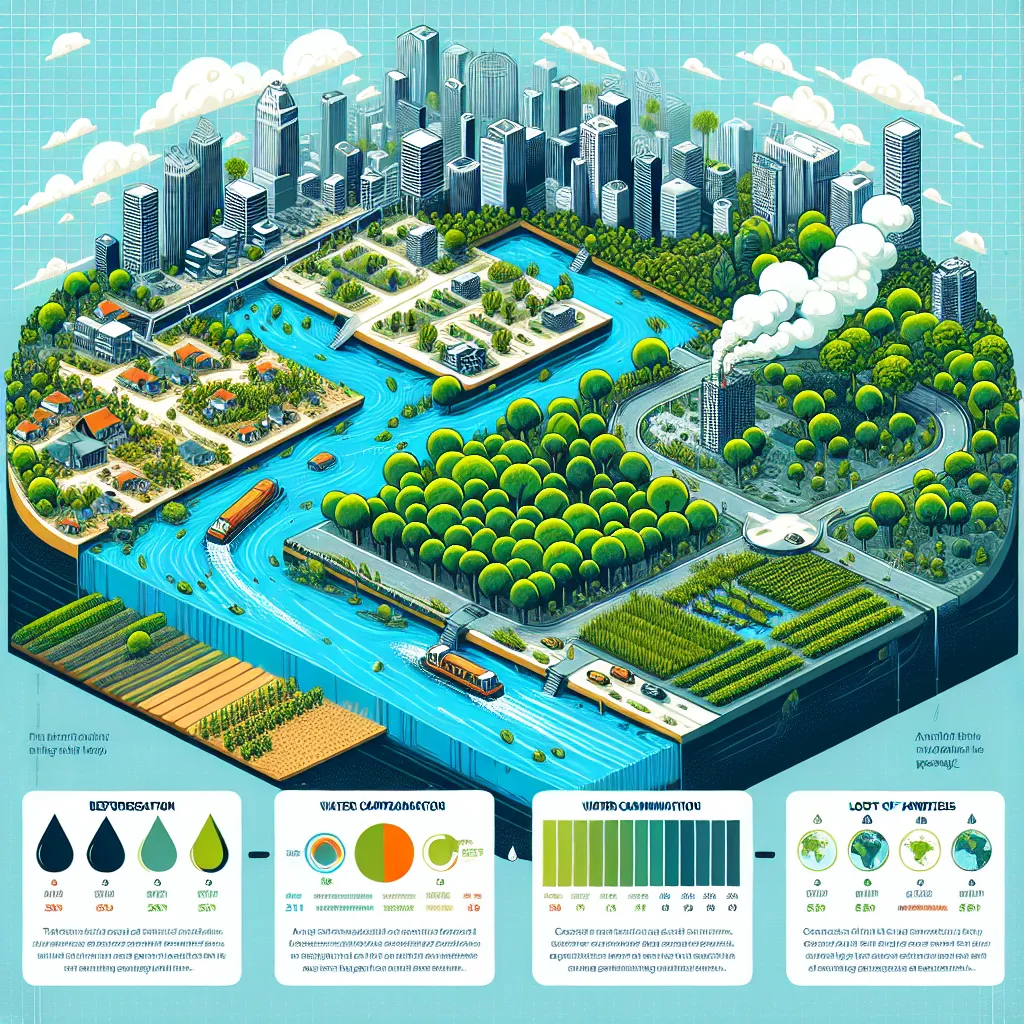In this IELTS Reading practice, we will explore the fascinating topic of “The role of AI in predicting natural disasters.” This subject is not only relevant to current technological advancements but also crucial for understanding how artificial intelligence is revolutionizing disaster preparedness and management. Let’s dive into a comprehensive IELTS Reading test that will challenge your comprehension skills while providing valuable insights into this important field.
Nội dung bài viết
 AI predicting natural disasters
AI predicting natural disasters
IELTS Reading Test: The Role of AI in Predicting Natural Disasters
Passage 1 – Easy Text
Artificial Intelligence (AI) has emerged as a powerful tool in the field of natural disaster prediction. In recent years, scientists and researchers have been harnessing the potential of AI to improve our ability to forecast and prepare for various natural calamities. This cutting-edge technology is revolutionizing the way we approach disaster management and mitigation.
One of the primary advantages of using AI in disaster prediction is its ability to process vast amounts of data quickly and accurately. Traditional methods of forecasting often rely on human analysis of historical data and current conditions. However, AI systems can analyze complex patterns and correlations that might be overlooked by human observers. This enhanced analytical capability allows for more precise predictions and earlier warnings.
AI-powered systems are being employed to predict a wide range of natural disasters, including earthquakes, hurricanes, floods, and wildfires. For instance, machine learning algorithms can analyze seismic data to identify patterns that may indicate an impending earthquake. Similarly, AI models can process satellite imagery and atmospheric data to predict the formation and trajectory of hurricanes with greater accuracy than ever before.
The integration of AI into disaster prediction systems has led to significant improvements in early warning systems. By providing more accurate and timely information, AI helps emergency responders and communities prepare more effectively for incoming disasters. This can result in reduced loss of life and property damage, as well as more efficient allocation of resources during disaster response efforts.
However, it’s important to note that AI is not a magic solution to all disaster prediction challenges. The technology still relies on quality data input and requires ongoing refinement and validation. Additionally, there are ethical considerations surrounding the use of AI in critical decision-making processes, especially when it comes to public safety.
Despite these challenges, the role of AI in predicting natural disasters continues to expand and evolve. As technology advances and more data becomes available, the potential for AI to save lives and mitigate the impact of natural disasters grows ever greater. The future of disaster prediction lies in the synergy between human expertise and artificial intelligence, working together to create a safer world for all.
Questions for Passage 1
1-5. Do the following statements agree with the information given in the passage?
Write
TRUE if the statement agrees with the information
FALSE if the statement contradicts the information
NOT GIVEN if there is no information on this
- AI can process data faster than traditional forecasting methods.
- AI systems are completely replacing human analysts in disaster prediction.
- Machine learning algorithms are being used to predict earthquakes.
- AI-powered disaster prediction is 100% accurate.
- The use of AI in disaster prediction raises ethical concerns.
6-10. Complete the sentences below.
Choose NO MORE THAN TWO WORDS from the passage for each answer.
- AI systems can analyze __ __ that humans might miss.
- AI models can process __ __ to predict hurricane formation and movement.
- The integration of AI has led to improvements in __ __ systems.
- AI technology still requires __ __ to function effectively.
- The future of disaster prediction involves a __ between human expertise and AI.
Passage 2 – Medium Text
The application of Artificial Intelligence (AI) in predicting natural disasters represents a significant leap forward in our ability to safeguard communities and infrastructure against the devastating effects of nature’s fury. This burgeoning field of study combines advanced machine learning algorithms, big data analytics, and sophisticated modeling techniques to create predictive systems that are more accurate and reliable than ever before.
One of the most promising areas of AI application in disaster prediction is in the realm of seismology. Traditional earthquake prediction methods have long been plagued by inaccuracies and false alarms. However, AI-driven approaches are changing this landscape. By analyzing vast datasets of seismic activity, including microseismic events that are too small for human detection, AI systems can identify subtle patterns and precursors that may indicate an impending earthquake. This has led to the development of more nuanced early warning systems that can provide crucial extra minutes or even hours of preparation time.
In the field of meteorology, AI is revolutionizing weather forecasting and hurricane prediction. Neural networks and deep learning models are being trained on decades of historical weather data, satellite imagery, and real-time atmospheric measurements. These AI systems can process and analyze this information at a scale and speed that far surpasses human capabilities. As a result, meteorologists can now predict the formation, intensity, and path of hurricanes with unprecedented accuracy, allowing for more effective evacuation plans and resource allocation.
Flood prediction is another area where AI is making significant strides. By integrating data from multiple sources such as rainfall patterns, river levels, soil moisture, and topographical information, AI models can simulate complex hydrological systems with remarkable precision. This enables authorities to predict flood risks and potential impact areas days or even weeks in advance, facilitating proactive measures to protect vulnerable communities and critical infrastructure.
The role of AI in predicting wildfires is also gaining traction. Machine learning algorithms analyze factors such as temperature, humidity, wind patterns, and vegetation density to assess fire risk and predict the potential spread of wildfires. Some advanced systems even incorporate data from social media and satellite imagery to detect fires in their early stages, enabling faster response times and more effective containment strategies.
Despite these advancements, the integration of AI into disaster prediction systems is not without challenges. One significant hurdle is the data quality and availability, especially in regions with limited monitoring infrastructure. Additionally, the interpretability of AI models remains a concern, as the complex decision-making processes of neural networks can be difficult for human experts to understand and validate.
Furthermore, there is an ongoing debate about the balance between AI-driven predictions and human expertise. While AI systems excel at processing vast amounts of data and identifying patterns, they may lack the contextual understanding and intuition that experienced human forecasters bring to the table. As such, many experts advocate for a hybrid approach that combines the strengths of both AI and human analysis.
As we look to the future, the role of AI in predicting natural disasters is set to expand further. Emerging technologies such as quantum computing and edge AI promise to enhance the speed and accuracy of predictive models even more. Moreover, the integration of AI with other advanced technologies like Internet of Things (IoT) sensors and 5G networks will enable real-time data collection and analysis on an unprecedented scale.
In conclusion, while AI is not a panacea for all the challenges associated with natural disaster prediction, it represents a powerful tool in our arsenal against nature’s unpredictability. As the technology continues to evolve and improve, it holds the promise of saving countless lives and mitigating the economic impact of natural disasters worldwide.
Questions for Passage 2
11-14. Choose the correct letter, A, B, C, or D.
-
According to the passage, AI in seismology:
A) Has completely replaced traditional earthquake prediction methods
B) Can detect microseismic events too small for human detection
C) Provides 100% accurate earthquake predictions
D) Is less effective than human analysis of seismic data -
In meteorology, AI systems:
A) Work independently of human meteorologists
B) Are limited to hurricane prediction
C) Can process data faster than humans
D) Have reduced the accuracy of weather forecasts -
The passage suggests that AI in flood prediction:
A) Is less effective than traditional methods
B) Can only predict floods a few hours in advance
C) Integrates data from multiple sources
D) Is not yet being used by authorities -
One of the challenges in using AI for disaster prediction is:
A) The lack of available data
B) The high cost of implementation
C) The interpretability of AI models
D) The resistance from human experts
15-20. Complete the summary below.
Choose NO MORE THAN TWO WORDS from the passage for each answer.
AI is revolutionizing natural disaster prediction in various fields. In seismology, AI can detect 15__ __ that humans cannot, improving earthquake prediction. For hurricane forecasting, AI uses 16__ __ and deep learning models to process vast amounts of data. Flood prediction benefits from AI’s ability to simulate complex 17__ __ . In wildfire prediction, AI analyzes factors like temperature and 18__ __ to assess fire risks. However, challenges remain, including issues with 19__ __ in some regions. Many experts recommend a 20__ __ that combines AI capabilities with human expertise.
Passage 3 – Hard Text
The integration of Artificial Intelligence (AI) in the prediction and management of natural disasters represents a paradigm shift in our approach to environmental hazards. This sophisticated synergy between cutting-edge technology and environmental science is not merely an incremental improvement but a revolutionary leap that promises to redefine our relationship with nature’s most formidable forces.
At the heart of this technological revolution lies the concept of predictive analytics, a field that has been dramatically transformed by the advent of machine learning and deep neural networks. These AI-driven systems are capable of ingesting and processing colossal volumes of heterogeneous data, including but not limited to satellite imagery, meteorological measurements, geological surveys, and historical disaster records. The true power of AI in this context lies not just in its ability to process this data at unprecedented speeds, but in its capacity to discern subtle patterns and correlations that would be imperceptible to even the most astute human analysts.
One of the most promising applications of AI in disaster prediction is in the domain of probabilistic forecasting. Traditional deterministic models, which attempt to provide a single “best guess” prediction, are increasingly being supplanted by AI-powered probabilistic models. These sophisticated systems generate a range of potential scenarios, each associated with a probability of occurrence. This approach not only provides a more nuanced understanding of potential outcomes but also allows for better risk assessment and decision-making in the face of uncertainty.
The efficacy of AI in disaster prediction is perhaps most strikingly demonstrated in the field of seismology. Earthquakes, long considered the most capricious and unpredictable of natural disasters, are now becoming more foreseeable thanks to AI. Advanced machine learning algorithms are being employed to analyze the subtle precursors of seismic activity, such as changes in ground deformation, electromagnetic signals, and even animal behavior. While we are still far from achieving precise earthquake prediction, AI has significantly improved our ability to assess seismic risk and provide more accurate early warnings.
In the realm of meteorology, AI is revolutionizing our approach to predicting extreme weather events. Convolutional neural networks, a class of deep learning algorithms particularly adept at processing spatial data, are being used to analyze satellite imagery and atmospheric data with unprecedented accuracy. This has led to significant improvements in our ability to forecast the formation, trajectory, and intensity of hurricanes and typhoons. Moreover, AI-powered systems are now capable of predicting flash floods and severe thunderstorms hours or even days in advance, providing crucial lead time for emergency responders and vulnerable communities.
The application of AI in wildfire prediction and management is another area of remarkable progress. Machine learning models are being trained on a diverse array of data sources, including historical fire records, vegetation indices, topographical data, and real-time weather conditions. These models can predict not only the likelihood of fire ignition but also simulate the potential spread and behavior of wildfires under various scenarios. This capability is proving invaluable for fire management agencies, enabling them to optimize resource allocation and develop more effective containment strategies.
However, the integration of AI into disaster prediction systems is not without its challenges and limitations. One of the most significant hurdles is the issue of data quality and availability, particularly in developing regions where monitoring infrastructure may be limited or non-existent. The data-hungry nature of AI algorithms means that their performance is heavily dependent on the quality and quantity of input data. Addressing this challenge will require significant investments in data collection infrastructure and international cooperation in data sharing.
Another critical consideration is the interpretability of AI models. Many advanced machine learning algorithms, particularly deep neural networks, operate as “black boxes,” making it difficult for human experts to understand and validate their decision-making processes. This lack of transparency can be problematic in the context of disaster prediction, where the stakes are incredibly high, and accountability is crucial. Ongoing research into explainable AI seeks to address this issue by developing methods to make AI decision-making processes more transparent and interpretable.
The ethical implications of relying on AI for disaster prediction and management also warrant careful consideration. Questions arise about the allocation of resources based on AI predictions, the potential for AI systems to perpetuate or exacerbate existing societal inequalities, and the balance between privacy and public safety in data collection and analysis.
Looking to the future, the role of AI in predicting natural disasters is set to expand even further. Emerging technologies such as quantum computing hold the promise of exponentially increasing the processing power available for complex simulations and data analysis. The integration of AI with other advanced technologies, such as the Internet of Things (IoT) and 5G networks, will enable real-time data collection and analysis on an unprecedented scale, potentially leading to the development of truly prescient disaster prediction systems.
In conclusion, while AI is not a panacea for all the challenges associated with natural disaster prediction and management, it represents a transformative force in our quest to better understand and mitigate the impacts of nature’s most destructive phenomena. As we continue to refine and expand the capabilities of AI in this domain, we move closer to a future where natural disasters, while still formidable, become increasingly manageable and less catastrophic in their impact on human life and society.
Questions for Passage 3
21-26. Complete the summary below.
Choose NO MORE THAN TWO WORDS from the passage for each answer.
AI has revolutionized natural disaster prediction through 21__ __, which can process vast amounts of diverse data. Unlike traditional models, AI-powered 22__ __ generate multiple scenarios with associated probabilities. In seismology, AI analyzes 23__ __ of seismic activity, while in meteorology, 24__ __ __ are used to improve weather forecasting. For wildfire prediction, AI models use various data sources to simulate fire 25__ __ . However, challenges remain, including issues with data quality and the 26__ __ of AI algorithms, which require significant input data.
27-32. Do the following statements agree with the information given in the passage?
Write
TRUE if the statement agrees with the information
FALSE if the statement contradicts the information
NOT GIVEN if there is no information on this
- AI has completely solved the problem of earthquake prediction.
- Convolutional neural networks are particularly effective in analyzing spatial data for weather forecasting.
- AI-powered systems can predict flash floods several weeks in advance.
- The performance of AI algorithms in disaster prediction is not affected by the quality of input data.
- There are ethical concerns about the use of AI in disaster prediction and management.
- Quantum computing is currently being used in AI-powered disaster prediction systems.
33-36. Choose the correct letter, A, B, C, or D.
-
According to the passage, one of the main advantages of AI in disaster prediction is its ability to:
A) Replace human analysts entirely
B) Provide 100% accurate predictions
C) Identify subtle patterns in large datasets
D) Eliminate the need for data collection -
The issue of interpretability in AI models refers to:
A) The difficulty in understanding their decision-making processes
B) The language barrier in international cooperation
C) The cost of implementing AI systems
D) The speed at which AI can process data -
The passage suggests that the future of AI in disaster prediction will likely involve:
A) Replacing all traditional prediction methods
B) Integration with other advanced technologies
C) Focusing solely on earthquake prediction
D) Reducing investment in data collection infrastructure -
The author’s overall view of AI in disaster prediction can be described as:
A) Highly skeptical
B) Cautiously optimistic
C) Entirely negative
D) Unreservedly enthusiastic
Answer Key
Passage 1:
- TRUE
- FALSE
- TRUE
- NOT GIVEN
- TRUE
- complex patterns
- satellite imagery
- early warning
- quality data
- synergy
Passage 2:
11. B
12. C
13. C
14. C
15. microseismic events
16. neural networks
17. hydrological systems
18. vegetation density
19. data quality
20. hybrid approach
Passage 3:
21. predictive analytics
22. probabilistic models
23. subtle precursors
24. convolutional neural networks
25. spread and behavior
26. data-hungry nature
27. FALSE
28. TRUE
29. FALSE
30. FALSE
31. TRUE
32. NOT GIVEN
33. C
34. A
35. B
36. B
Conclusion
This IELTS Reading practice test on “The role of AI in predicting natural disasters” has provided a comprehensive exploration of this critical topic. By tackling these passages and questions, you’ve not only enhanced your reading comprehension skills but also gained valuable insights into the cutting-edge applications of


